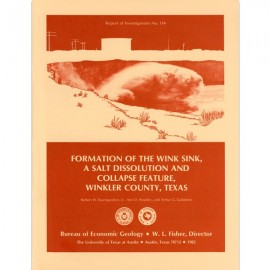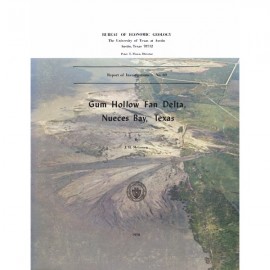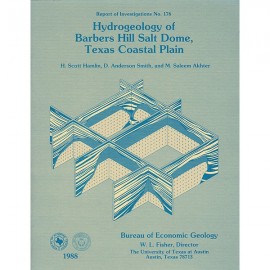Reports of Investigations
-
Books & Reports
- Reports of Investigations
- Guidebooks
- Udden Series
- Geological Circulars
- Down To Earth
- Atlases of Major Oil and Gas Reservoirs
- Texas Memorial Museum Publications
- Environmental Geologic Atlas of the Texas Coastal Zone
- Mineral Resource Circulars
- Other Reports
- Seminars and Workshops
- Handbooks
- Submerged Lands of Texas
- Symposia
- Annual Reports
- Open File Reports
-
Maps & Cross Sections
- Thematic Maps
- Miscellaneous Maps, Charts & Sections
- Geologic Atlas of Texas
- STATEMAP Project Maps
- Geologic Quadrangle Maps
- Cross Sections
- Highway Geology Map
- Energy and Mineral Resource Maps
- Shoreline Change and Other Posters
- Wilcox Group, East Texas, Geological / Hydrological Folios
- Bouguer Gravity Atlas of Texas
- River Basin Regional Studies
- Featured Maps
- Posters
- Teachers & the Public
-
Geological Society Publications
- Gulf Coast Association of Geological Societies
- Alabama Geological Society
- Austin Geological Society
- Corpus Christi Geological Society
- Houston Geological Society
- Lafayette Geological Society
- Mississippi Geological Society
- New Orleans Geological Society
- South Texas Geological Society
- GCS SEPM Publications
- Historic BEG & UT Series
Landsat Analysis of the Texas Coastal Zone
RI0093
Landsat Analysis of the Texas Coastal Zone, by R. J. Finley. 71 p., 29 figs., 12 tables, 5 maps, 1 plate, 1979. ISSN: 0082335X: Print Version.
A free, digital version of this publication can be found on: Texas ScholarWorks
RI0093. Landsat Analysis of the Texas Coastal Zone, by R. J. Finley. 71 p., 29 figs., 12 tables, 5 maps, 1 plate, 1979. ISSN: 0082335X: Print.
To purchase this publication as a downloadable PDF, please order RI0093D.
ABSTRACT
Mapping based on Landsat imagery was initiated along the Texas coast for four test sites selected for contrasting vegetation, environmental geology, and levels of economic development. Standard Landsat transparencies of part of a 1:1,000,000 band 7 image were optically enlarged to fit an existing 1:125,000 map base. Land-water, cropland, and other distinctive boundaries were extracted from the enlargement and compiled on an overlay on which additional unit boundaries from other bands and from the false-color composite of bands 4, 5, and 7 were added.
Each resulting map unit was then classified according to a bilevel scheme modified from published systems to meet the priorities of this study. These priorities are, in order of greatest emphasis, the inventorying and monitoring of wetlands, land use, beaches and dunes, and bay systems. Primary classes include urban and built-up land, agricultural land, grassland, rangeland, woodland, water, wetland, and barren land. Twenty -three secondary categories include five wetland classes: topographically low marshes, topographically high marshes, tidal flat, submerged sea-grass beds and algal flats, and vegetated dredge spoil. Water was separated into four classes on the basis of turbidity to emphasize flow pattern and suspended-sediment distribution rather than water-body type.
Change detection was accomplished by overlaying enlarged positive and negative transparencies. Areas of radiance change were caused by seasonal growth stage of wetland vegetation, burning of rangeland, and status of cropland. Multiple transparencies in bands 5 and 7 were used to map the addition of barren dredge spoil, a unit that was easily detected as a result of its extremely high reflectance. Band 5 images provided a synoptic view of the turbidity plume issuing from Aransas Pass and indicated that turbid water was derived from both the inlet and the surf zone adjacent to the jetties.
The test sites mapped were the Freeport - San Luis Pass area, the upper San Antonio Bay - Espiritu Santo Bay vicinity, southern Padre Island - Laguna Madre, and the Harbor Island area. Substantial variation in areal extent and species content of wetlands was found. The limits of delineation of all categories depended on the size of the map unit relative to Landsat's limit of resolution, reflectivity contrast with surrounding units, and unique characteristics of each image. Mapping of the Harbor Island site from three successive scenes showed significant variations in the detectability of urban and transportation features.
An evaluation of the Landsat mapping was made by a random-point comparison with aerial photographs. A mean accuracy of 87.4 percent was obtained for the 806 points checked; within each category, results varied from 64.9-percent accuracy for undifferentiated barren land to 93.1-percent accuracy for cropland. The results indicate that Landsat offers a valuable source of current information on coastal resources for use in conjunction with the existing data base on Texas coastal resources.
Keywords: Landsat, Texas, TCZ, coastal zones, remote sensing, South Texas, Texas Coastal Zone, mapping
Citation
Finley, R. J., 1979, Landsat Analysis of the Texas Coastal Zone: The University of Texas at Austin, Bureau of Economic Geology, Report of Investigations No. 93, 71 p.






